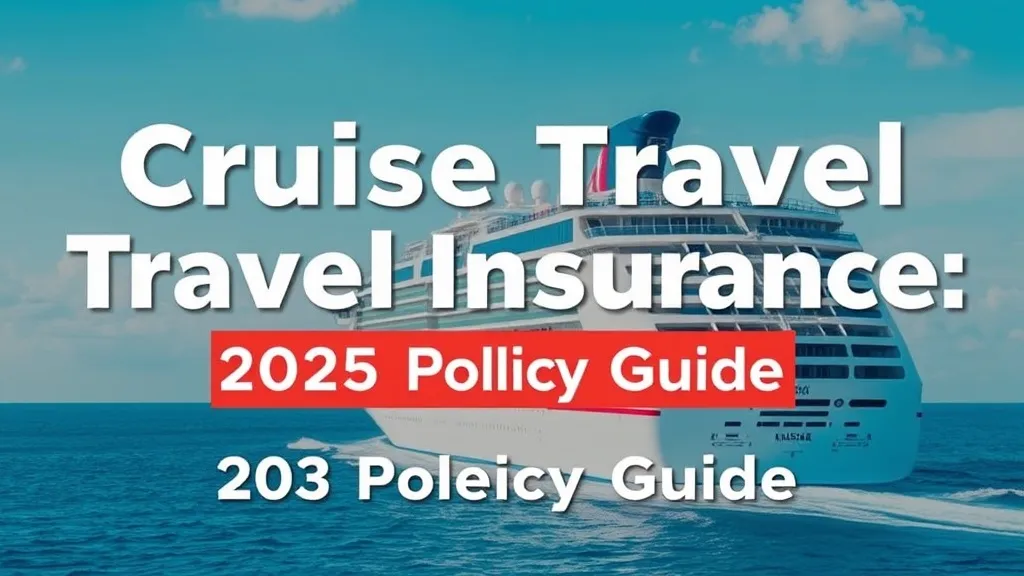Cruise Travel Insurance: 2025 Policy Guide
Planning a cruise is exciting, but you never know when a storm or a missed port can derail your plans—so cruise travel insurance should be at the top of your checklist. You’ve looked forward to sunsets at sea, immersive shore excursions, and buffets galore, but what happens if illness, weather, or itinerary changes cut your fun short? Interestingly enough, 35% of cruise itineraries in 2023 saw at least one port change due to weather or operational issues1. Here’s the thing: a solid policy can save you thousands—and endless headaches. In this guide, you’ll discover exactly how cruise travel insurance works, why it’s essential for your 2025 voyages, and how to pick the right plan. Ready? Let’s dive in.
Table of Contents
- What Is Cruise Travel Insurance?
- Why You Need Cruise Travel Insurance in 2025
- Key Coverage Types and How They Work
- How to Choose the Best Cruise Travel Insurance Policy
- Timing Your Purchase and CFAR Options
- Claims Process: What to Expect on Board and After
- Future Trends in Cruise Travel Insurance
- FAQ
- Conclusion
What Is Cruise Travel Insurance?
Ever wondered what cruise travel insurance really covers? It’s not just an extra expense; it’s peace of mind on the high seas. At its core, this type of policy bundles coverage for cancellations, medical emergencies, lost luggage, and sometimes even missed ports into one package.
Medical emergencies at sea can cost upwards of $50,000 if you need evacuation. Without proper coverage, you’re on the hook for every dollar. And let’s face it—nobody plans to fall ill on vacation.
When Sarah’s Caribbean cruise got rerouted due to a hurricane, her policy reimbursed her airfare change fees and hotel nights ashore—even though the cruise line offered no compensation. That meant a $1,200 saving and zero stress.
“Cruise travel insurance is your buffer against the unexpected,” says John Stevens, President of the U.S. Travel Insurance Association.
Actionable Takeaway: Always read the policy definitions for terms like “trip interruption” and “emergency evacuation.” They differ by provider.
Why You Need Cruise Travel Insurance in 2025
Imagine missing a dream port because a fierce storm rolled in. It’s more common than you think. Climate change disruptions have doubled itinerary changes over the last five years.
Tin Leg now offers up to $1,000 per person for missed shore excursions, reflecting this growing risk1. That kind of cushion can cover a private tour or extra hotel night when the ship sails without you.
Plus, with medical costs skyrocketing, emergency evacuation insurance is non-negotiable. In 2022, over 40% of cruise medical incidents required helicopter transfers—each costing $15,000 or more.
Actionable Takeaway: Look for a policy with specific missed port departure coverage and robust medical evacuation limits of at least $100,000.
Key Coverage Types and How They Work
Medical emergencies, lost luggage, or a canceled port—you’ve heard it all, but what’s actually covered?
- Trip cancellation/interruption
- Medical and emergency evacuation
- Missed port departures
- Baggage delay or loss
- Cancel For Any Reason (CFAR) options
Trip cancellation covers non-refundable costs if you must cancel for a covered reason, like illness. Interruption reimburses unused portions if you cut your trip short.
Baggage coverage steps in when your luggage takes a detour. Many policies now pay out within 48 hours if your bags are delayed past 12 hours.
According to a 2024 industry report, streamlined digital claims processing speeds up reimbursements by 40% compared to traditional paper-based systems.
When John’s luggage went missing on his Mediterranean cruise, digital claims allowed him to buy essentials immediately—and get reimbursed before he even docked.
Actionable Takeaway: Compare coverage limits and digital claims options. Higher limits and faster reimbursements mean less hassle on shore.
How to Choose the Best Cruise Travel Insurance Policy
Selecting the right policy can feel like navigating uncharted waters. Where do you start?
Between annual plans, single-trip coverage, and CFAR add-ons, each option has pros and cons.
- Assess your trip’s value and risk level.
- Compare coverage details—watch for sub-limits and exclusions.
- Check clauses for pre-existing conditions.
- Read customer reviews, especially on claim settlements.
- Verify the provider’s financial strength and ratings.
Emma, a frequent cruiser, swears by an annual multi-trip plan because it covers all her jaunts for one fee.
“Annual plans with cruise cover save both time and money for avid travelers,” notes an expert at AXA Travel Insurance2
Actionable Takeaway: Use a comparison site or speak with a broker to match coverage features to your itinerary. And don’t skip a peek at customer feedback.
Explore more on Annual Travel Insurance: 2025 Multi-Trip Plans“>annual cruise travel insurance plans and How Does Travel Insurance Work? A 2025 Guide“>how to choose cruise travel insurance.
Timing Your Purchase and CFAR Options
Timing is everything—especially if you want CFAR protection. Cancel For Any Reason coverage gives you the ultimate flexibility.
Most insurers require you to buy CFAR within 7–21 days of your initial trip deposit. Delay, and you lose this option.
Mark booked CFAR within 10 days and later canceled when a family emergency popped up—getting back 75% of his cruise fare.
Quick Tip: Set a calendar reminder for your CFAR purchase window. One missed day, and you’re out of luck.
Actionable Takeaway: If your itinerary or health situation is uncertain, invest in CFAR early. It’s pricier but worth the peace of mind.
Claims Process: What to Expect on Board and After
Making a claim shouldn’t feel like another voyage. The truth is, most top providers now use mobile apps to streamline the process.
Start by documenting every expense: receipts, photos, medical reports. Submit via app or online portal within 30 days.
After falling ill on a Mediterranean cruise, Laura snapped photos of her hospital bills, uploaded them via her insurer’s app, and received payment in 10 days.
“Digital claims reduce processing time dramatically,” says a spokesperson from Seven Corners.
Actionable Takeaway: Keep digital copies of all documents. Use an app that syncs across devices to avoid lost paperwork.
Future Trends in Cruise Travel Insurance
Curious where the industry is headed? Technology integration and sustainability are steering the ship.
Some insurers are piloting blockchain for secure policy issuance and claims tracking. Others offer carbon-offset add-ons to fund greener cruise operations.
Royal Caribbean recently partnered with an insurer to trial wearable health monitors that automatically trigger emergency protocols—talk about next-level coverage3.
Actionable Takeaway: Keep an eye on feature updates. Early adopters often get promotional rates on innovative coverage options.
FAQ
- Do I need separate insurance if I already have travel insurance?
- Often, standard travel insurance has gaps for cruise-specific risks like missed ports. Check your policy’s cruise add-on options.
- Can I add pre-existing condition coverage?
- Yes, many policies offer a Pre-Existing Conditions Waiver if you purchase within the insurer’s time frame and meet health criteria.
- Is CFAR worth the extra cost?
- If your plans might change or you want flexibility, CFAR can be a lifesaver despite the higher premium.
Conclusion
Choosing the right cruise travel insurance can transform your holiday from risky to worry-free. We’ve explored definitions, coverage types, timing, claims processes, and future trends. Now it’s time to act:
- List your trip costs and risk factors.
- Get quotes from at least three reputable providers.
- Purchase within deposit windows to secure CFAR and pre-existing condition benefits.
The bottom line is that a little preparation goes a long way. Smooth sailing awaits with the right coverage.





